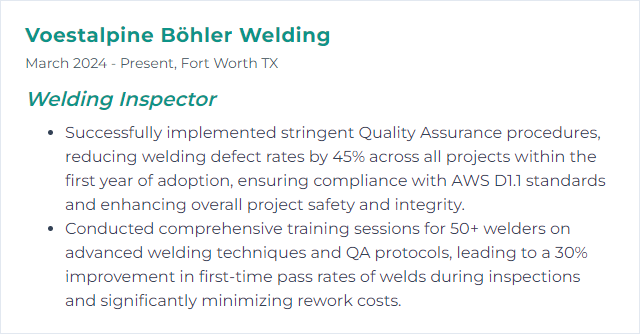Top 12 Welding Inspector Skills to Put on Your Resume
In the competitive world of welding inspection, the skills you show on a resume can tilt the table in your favor. Hiring managers look for proof you can find defects fast, judge acceptance precisely, and keep work compliant without slowing production. Put the right capabilities front and center and your experience lands with weight.
Welding Inspector Skills
- Ultrasonic Testing
- Radiographic Testing
- Magnetic Particle Inspection
- Dye Penetrant Inspection
- AWS Certification
- ASME Standards
- Visual Inspection Techniques
- Welding Metallurgy
- ISO 9001
- NDT Techniques
- Welding Codes
- Quality Assurance Procedures
1. Ultrasonic Testing
Ultrasonic Testing (UT) is a non-destructive method that fires high-frequency sound into a weld to reveal internal flaws, measure thickness, and gauge bond quality. Clean, fast, and highly sensitive when set up right.
Why It's Important
UT exposes internal discontinuities—cracks, lack of fusion, porosity clusters—without harming the part. It supports precise sizing and acceptance decisions against code criteria, which anchors safety and reliability.
How to Improve Ultrasonic Testing Skills
- Keep technique sharp: Refresh knowledge of straight-beam, angle-beam, phased array, and TOFD. Know when each shines.
- Use the right setup: Probe selection, frequency, wedges, couplant, and scanning patterns matter. Calibrate with the correct blocks and verify sensitivity before you start.
- Control variables: Surface condition, temperature, and coupling pressure can skew results. Stabilize them.
- Practice interpretation: Spend time on signal characterization and defect profiling. Record indications, compare with known reflectors, and validate with backup methods when needed.
- Stay aligned with standards: Follow applicable procedures and acceptance criteria from project codes and company practices. Document everything cleanly.
How to Display Ultrasonic Testing Skills on Your Resume
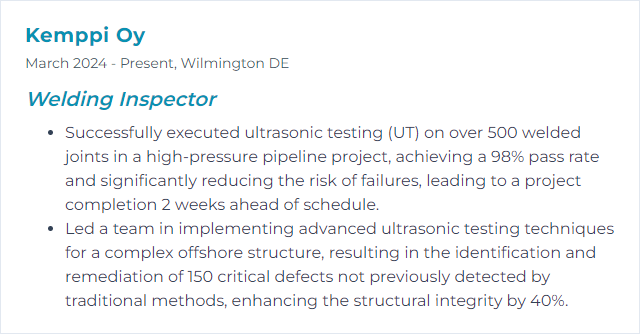
2. Radiographic Testing
Radiographic Testing (RT) uses X-ray or gamma radiation to generate images that reveal internal weld quality. Film, computed radiography (CR), or digital detector arrays (DDA) can all be in play.
Why It's Important
RT captures a permanent record of volumetric defects—porosity, slag, lack of fusion—deep inside the joint. It’s often mandated for critical pressure and structural work.
How to Improve Radiographic Testing Skills
- Tune exposure: Source-to-object distance, energy, and time drive image quality. Nail geometric unsharpness and contrast.
- Leverage modern tech: Where permitted, CR/DDA can boost sensitivity and speed while cutting consumables.
- Interpret with rigor: Learn artifact recognition, scatter patterns, and film/digital density control. Calibrate your eye.
- Follow the rulebook: Apply relevant code and standard requirements (e.g., ISO 17636-1/2 and project codes) precisely.
- Keep safety paramount: Plan barricades, badges, surveys, and ALARA practices. No shortcuts with radiation.
How to Display Radiographic Testing Skills on Your Resume

3. Magnetic Particle Inspection
Magnetic Particle Inspection (MPI/MT) finds surface and near-surface flaws in ferromagnetic materials by magnetizing the part and watching how particles gather at leakage fields.
Why It's Important
It’s quick, sensitive to tight surface cracks, and great for weld toes, root areas, fillets, and attachments where fatigue loves to start.
How to Improve Magnetic Particle Inspection Skills
- Prep the surface: Clean metal, right roughness, no loose scale. Visibility skyrockets when prep is right.
- Get field direction right: Magnetize perpendicular to expected crack orientation. Change direction and overlap for complex geometry.
- Control field strength: Verify amperage, check field adequacy (e.g., QQI/shims), and avoid over/under magnetization.
- Optimize media: Choose wet fluorescent for sensitivity or dry powder for portability. Verify UV-A intensity and ambient light for fluorescent work.
- Demagnetize and document: Reduce residual fields if required and record indications clearly with size, location, and disposition.
How to Display Magnetic Particle Inspection Skills on Your Resume

4. Dye Penetrant Inspection
Dye Penetrant Inspection (PT, often called DPI/DPT) reveals surface-breaking flaws in non-porous materials using a penetrant, removal step, and developer to pull dye back out of discontinuities.
Why It's Important
It’s simple, cheap, and highly effective for surface cracks, especially on nonmagnetic materials where MT can’t play.
How to Improve Dye Penetrant Inspection Skills
- Clean like it matters: Degrease, dry, and avoid residues. Contamination hides cracks and creates false calls.
- Mind dwell times: Use the correct soak time for the penetrant family and material. Too short hides, too long smears.
- Remove with care: Follow the system type (water-washable, post-emulsifiable, solvent-removable) and avoid over-cleaning.
- Choose the developer: Dry, aqueous, or non-aqueous—apply evenly and allow proper develop time before evaluation.
- Control lighting: Adequate white light for visible systems; calibrated UV-A and dark adaptation for fluorescent.
How to Display Dye Penetrant Inspection Skills on Your Resume
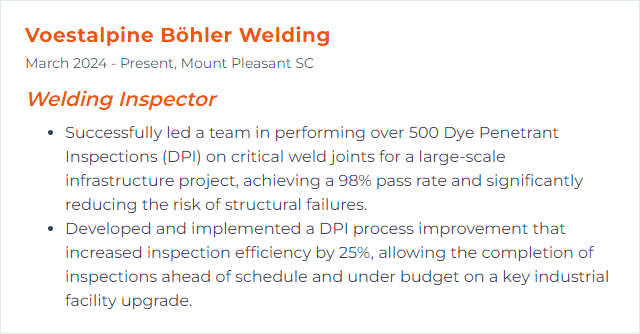
5. AWS Certification
AWS certification—most notably the Certified Welding Inspector (CWI)—validates knowledge of welding processes, inspection methods, safety, and code application. It signals readiness to make defensible calls in the field.
Why It's Important
It boosts credibility, unlocks project access, and aligns your work with recognized standards. Employers notice. Clients trust it.
How to Improve AWS Certification Skills
- Master the exam structure: Part A (fundamentals), Part B (hands-on/practical), Part C (code application). Pick a code book wisely and learn its layout cold.
- Build real experience: Time under a seasoned inspector accelerates judgment and speeds your code navigation.
- Train with purpose: Target weak areas with focused courses and practice exams. Simulate time limits.
- Stay current: Track errata, code revisions, and renewal requirements. Keep your vision acuity and continuing education up to date.
How to Display AWS Certification Skills on Your Resume
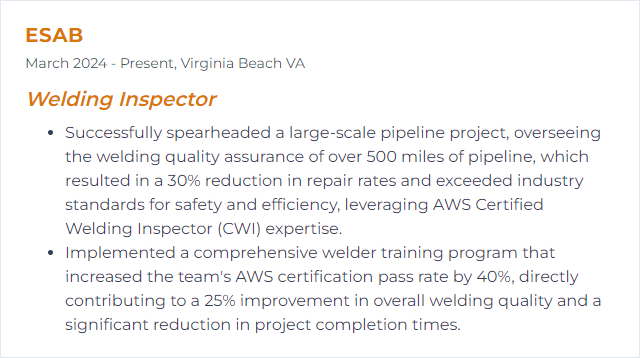
6. ASME Standards
ASME standards and codes define requirements for design, fabrication, qualification, and inspection across pressure equipment and piping. Inspectors frequently work with Section IX (qualification), Section VIII (vessels), and B31 piping codes.
Why It's Important
They provide a shared rule set. When you apply them consistently—test coupons to acceptance criteria—you reduce risk and keep equipment safe under pressure.
How to Improve ASME Standards Skills
- Know the structure: Understand how Section IX ties to construction codes and how project specs add restrictions.
- Trace the paperwork: Map WPS/PQR/WPQ links. Check essential and supplementary essential variables with care.
- Practice acceptance calls: Work sample problems and mock inspections. Decide, justify, document.
- Engage in updates: Track code addenda and revisions. Note changes to qualification ranges, toughness rules, or NDE requirements.
How to Display ASME Standards Skills on Your Resume
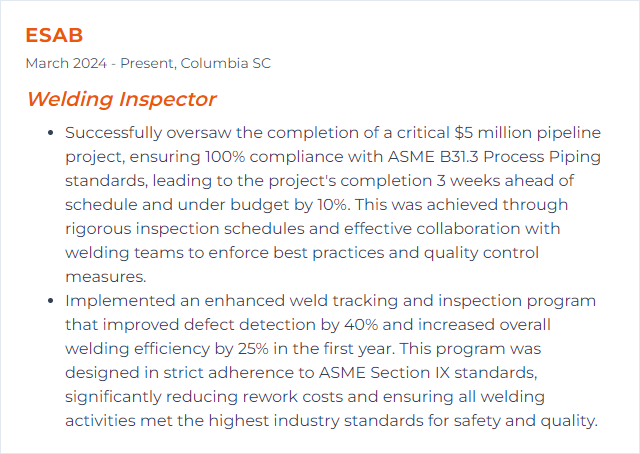
7. Visual Inspection Techniques
Visual testing (VT) relies on trained eyes, good lighting, and simple tools—fillet gauges, hi-lo gauges, bridge cams, mirrors, borescopes—to find surface issues before they become expensive problems.
Why It's Important
VT is the first line of defense. Cheap, immediate, and able to catch many defects early so repairs stay small and schedules steady.
How to Improve Visual Inspection Techniques Skills
- Work the basics: Clean surfaces, clear access, and correct lighting levels. Your eyes can only judge what they can truly see.
- Use the right gauges: Measure reinforcement, undercut, misalignment, and size instead of guessing.
- Standardize checks: Build checklists for pre-weld, in-process, and final inspection hold points. Consistency beats memory.
- Train recognition: Study defect morphology—hot vs cold cracks, crater cracks, profile issues—and link causes to fixes.
How to Display Visual Inspection Techniques Skills on Your Resume
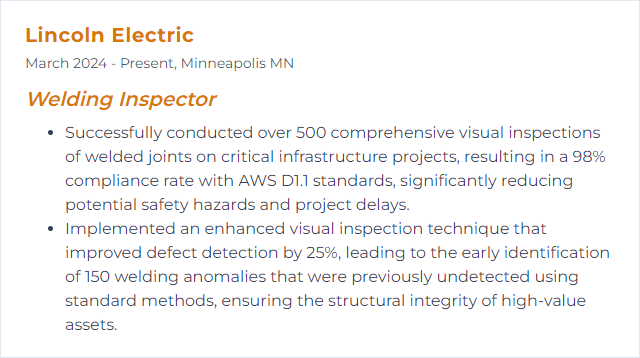
8. Welding Metallurgy
Welding metallurgy examines how heat and cooling reshape microstructures in the weld and heat-affected zone. Strength, toughness, hardness—everything shifts with composition and cooling rate.
Why It's Important
Cracking risk, distortion, residual stress, and service performance depend on metallurgy. Get it wrong and failures creep in. Get it right and welds behave as designed.
How to Improve Welding Metallurgy Skills
- Calculate carbon equivalent: Predict hardenability and preheat needs. Hydrogen cracking hates warm, dry steel.
- Control heat input: Balance penetration and toughness. Track interpass temperature and travel speed.
- Match filler wisely: Align strength, toughness, and chemistry with the base metal and service environment.
- Apply PWHT when needed: Relieve stress, temper hard zones, and meet code rules for thickness and material.
- Study defect causes: Link porosity, lack of fusion, underbead cracking, or lamellar tearing back to metallurgical roots.
How to Display Welding Metallurgy Skills on Your Resume
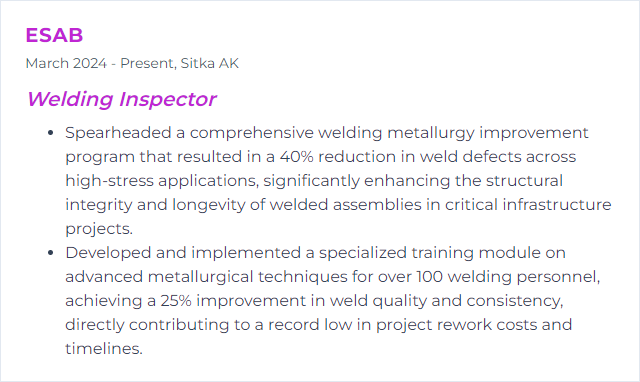
9. ISO 9001
ISO 9001 sets the framework for a quality management system. For inspection, it means process control, risk-based thinking, documented procedures, and continuous improvement tied to welding quality.
Why It's Important
It drives consistency. Traceability, calibration, training, nonconformance control—everything that keeps inspection reliable and repeatable.
How to Improve ISO 9001 Skills
- Integrate ISO 3834: Link welding-specific quality requirements with your QMS so shop floor reality matches paperwork.
- Tighten documentation: Clear ITPs, calibrated equipment logs, WPS/PQR/WPQ control, and welder continuity records that auditors can follow.
- Measure what matters: Track repair rates, defect categories, turnaround times, and supplier performance. Act on the data.
- Strengthen CAPA: Root cause analysis that fixes the system, not just the symptom. Close the loop and verify effectiveness.
How to Display ISO 9001 Skills on Your Resume
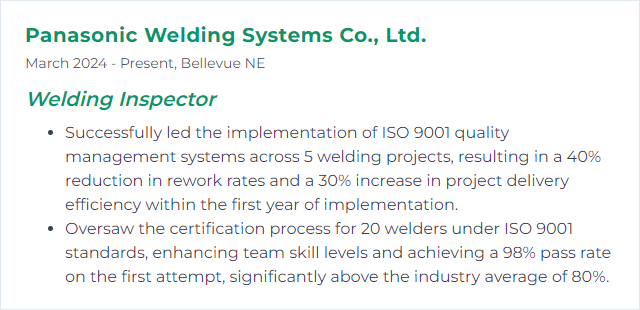
10. NDT Techniques
NDT techniques let you interrogate welds without harming them: UT, RT, MT, PT, VT, PAUT, TOFD, and more. Choose the method that fits the defect type and geometry.
Why It's Important
It protects integrity while keeping parts in service. Early detection saves money, prevents downtime, and safeguards people.
How to Improve NDT Techniques Skills
- Broaden your toolkit: Add phased array and TOFD for sizing, consider eddy current for surface flaws, and leak testing for tightness checks.
- Calibrate and verify: Use proper reference blocks and sensitivity checks. Record setups so results are repeatable.
- Advance your level: Work toward higher certification levels under your governing scheme (e.g., SNT-TC-1A, CP-189, or ISO 9712).
- Manage data well: Store scans, images, and reports cleanly. Good data makes audits painless and trend analysis possible.
How to Display NDT Techniques Skills on Your Resume
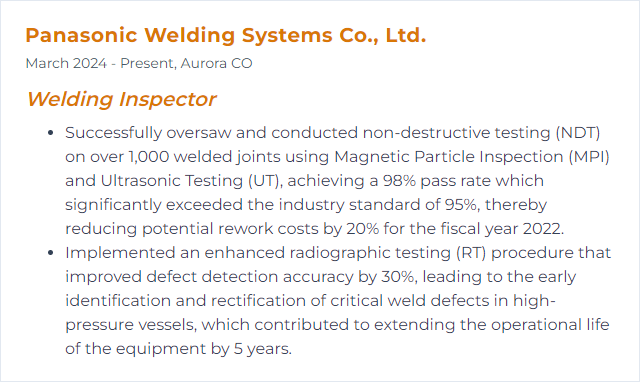
11. Welding Codes
Welding codes set the acceptance criteria, qualification rules, and inspection scope. Common ones include AWS D1.1, ASME BPVC and B31 series, API 1104, and related international standards.
Why It's Important
They define “good enough” in black and white. Your job is to apply them consistently, even under schedule pressure.
How to Improve Welding Codes Skills
- Map requirements: Align contract specs, project procedures, and governing codes. When conflicts appear, know which rules win.
- Practice code navigation: Build speed finding variables, essential tables, and acceptance charts.
- Work examples: Solve real-world scenarios—welder qualification ranges, WPS variables, NDE percentage, and repair approval steps.
- Track revisions: Keep a change log for new editions so your calls stay current.
How to Display Welding Codes Skills on Your Resume

12. Quality Assurance Procedures
Quality Assurance (QA) procedures wrap the entire workflow—planning, qualification, inspection, test, and release—so every weld meets the spec the first time.
Why It's Important
Good QA prevents escapes, trims rework, and adds traceability. It’s the backbone of predictable performance.
How to Improve Quality Assurance Procedures Skills
- Strengthen ITPs: Define hold and witness points, acceptance criteria, and records. No ambiguity.
- Tight control of qualifications: Validate WPS/PQR/WPQ linkages and maintain welder continuity. Audit it regularly.
- Calibration discipline: Keep gauges, UV meters, densitometers, UT sets, and dosimeters in calibration with clear stickers and traceable certificates.
- Close the loop: Log NCRs, perform root cause, assign corrective actions, and verify effectiveness on subsequent work.
How to Display Quality Assurance Procedures Skills on Your Resume
